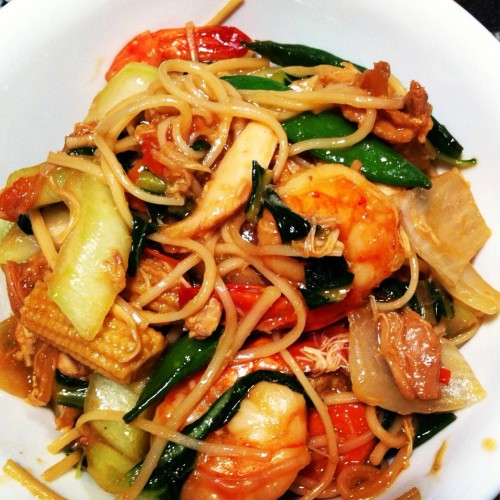How to Sauté
Listen up bit@hes, because this is the most important technique that I can teach your sorry ass. When you learn how to sauté properly, this easy technique will allow you to make meals out of basically anything you have lying around your kitchen. You can also use this technique to keep the kids in line. A couple of sautéed fingers never killed anyone.
SO, WHAT THE F%@K IS SAUTÉ?
First, a little linguistics lesson. The word sauté is from the french word “sauter” meaning “to jump.” The reason why it has been adapted to describe this method of cooking is because the object is to keep the food moving in the heat of the pan. If you don’t keep the food moving, then you will f%@k it up, and fail like the stupid little bitch that you are. When you sauté, you use a fatty substance like butter or oil to transfer the heat of the pan to the food ingredients. There are four important tips I can give you so that you can be successful:
- Make sure the pan is heated before applying the oil and the food ingredients. This is important for three reasons. One, you want to make sure the fat doesn’t break down as it heats up. Two, you want to make sure the pan is uniformly hot. And three, if you are cooking meat of some sort, it will sear in the juice and allow the end product to be a lot more succulent.
- Keep the food moving with either a wooden spoon or other utensil that won’t scratch the pan. Professional chefs might toss the food around the pan. But you, my dear, are not a professional chef. So don’t you dare try to do this. You will end up with a floor full of oily food or worse, in the hospital with third-degree burns on your face. Don’t be a stupid bitch. Use the damn spoon.
- Use only enough oil or butter to coat the bottom of the pan. This is not deep-frying, bitch! Don’t drown the damn food. Just give it enough fat so that you can transfer the heat of the pan.
- Pay attention to the ingredients damn it! If you are using a mix of vegetables and meats, know that they cook at different speeds. I like to always start with what I call a “flavoring” vegetable like onion, garlic or shallots, then follow with the meat, and eventually the rest of the vegetables. This way the oil will be flavored before I put the meat in, and the rest of the vegetables won’t be overcooked. Obviously this may vary if you are following a recipe. Also, make sure the vegetables are similar in size. This will help you to cook them uniformly.
Don’t confuse sautéing with pan-frying where you use more oil, keep the food whole (don’t chop it), and let the food sit. We will talk more about pan-frying next, so hold your damn horses.
BUTTER OR Oil?
I can just hear your whining little voices… “Should I use butter or oil? And if it is oil, what kind of oil?…Oh, and why use different types of oil?…wah wah wah!” Just stifle yourself for a moment and let me talk. When I am cooking different cuisines, I use different types of fat. The difference is the flavor and the “smoking point.” No, I’m not talking about the point where you light up bitches. In this case, it’s the instance where the oil begins to smoke and therefore burn. Butter has a lower smoking point than oil, but a richer flavor. Therefore, when you use butter, keep it on a lower heat. Olive Oil has a lower smoking point than vegetable oil, but also a heartier flavor. So, to keep it simple, here is a little guideline I use… and hence, you should too.
OIL OR BUTTER, Bit@h?
Rich Cuisines like French—Butter
Italian and Mediterranean Cuisine—Olive Oil
Asian Cuisine—Sesame Oil
Mexican Cuisine—Vegetable, Canola Oil
If in doubt, I will fall back on the olive oil. A lot of the flavor of the oil you use will fade as it cooks, so I just tend to go with the healthier of the bunch, and that is Olive Oil. However, I do find that no matter how long I cook the food, Sesame Oil is the best in Asian dishes. Once you get the hang of it, you can also combine butter and oil to come up with a great rich flavor as well. Try it out, bitch. The worst that can happen is you burn the house down.
SO HOW DAMN HOT SHOULD THE PAN BE?
Listen to you… all full of stupid questions. Well simply put, I like to set the pan to a medium heat before I apply the fat of choice. This will ensure that the fat won’t burn as soon as you put it in the pan, and provides a good starting point to increase the heat if necessary (which is usually necessary).
TIPS FOR SAUTÉING
When I sauté, I preheat the pan on medium, add the oil or butter and let that heat up for about 30-60 seconds. I then add the onions and garlic. At this point, I raise the heat to medium-high and flavor with a dash of salt and pepper. The salt helps the onion and garlic flavor to “sweat” into the oil. After about a minute or two, I add the meat, and if there is some liquid flavor (like soy sauce, wine, or vinegar) I will add that after the meat has been sautéing for 45 seconds or so. It is important to add any liquid flavor after you have put some ingredients in the pan. This is so that the pan can cool down a bit and the liquid won’t splatter and kill someone. At this point I will start to add any other vegetables I plan to use. I find that this gives the meat the best flavoring and allows the vegetables to cook properly.
So that’s it, bitch. That is how to sauté your man’s meat…er… I mean sauté some meat. Don’t f%@k it up.


